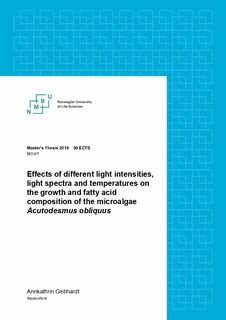| dc.description.abstract | The subject of this thesis were the effects of cultivation of different light intensities, spectral light areas and temperatures on growth and fatty acid composition in the microalgae Acutodesmus obliquus. While previous experiments mainly used light emitting diodes and looked at light effects of narrow line spectra, filter foils were used in this study to analyse the differences in growth and fatty acid profiles caused by spectral areas of visual blue, green and red light. Cultivation temperatures between 20 °C and 35 °C were tested with light intensities between 120 μmol m-2 s -1 and 800 μmol m-2 s -1 . The established opinion, that the usage of green light for cultivation of plants leads to low biomass growth, was disproved in the case of A. obliquus, which had high growth values under green light cultivation. Growth was always best in the fill solar spectrum control group, followed by the red light group. With increasing biomass concentrations, the differences between the biomass values for the red and green light group became less significant and the green light group outperformed the red light group during high light intensity. Cultivation under blue light always gave the lowest growth values. With increasing light intensities, growth increased. The best biomass results were achieved for cultivation at 30 °C under 800 μmol m-2 s -1 in the green light and full solar spectrum control group. Lipids of the algae were extracted, and fatty acids were subsequently analysed by GC-MS. The main fatty acids of A. obliquus were the saturated fatty acid 16:0 with around 44 % and the polyunsaturated fatty acid 18:3 with around 21 %. With increasing temperatures, overall saturation in the fatty acid profile of A. obliquus increased and this effect was highest when using red spectral light. A cultivation temperature of 20 °C gave the most favourable fatty acid composition, meaning a high amount of polyunsaturated and less saturated fatty acids. However, growth under these conditions was low. The second best fatty acid composition was achieved in the experiment using high intensities, which also gave the best growth results, especially for green and full solar light. This combination is therefore recommended if the aim is the commercial production of polyunsaturated fatty acids from A. obliquus. | nb_NO |

